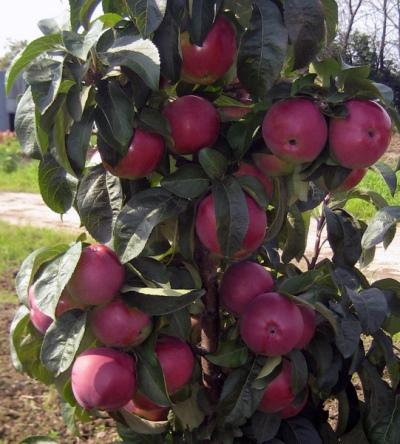
- Taste: dessert
- Fruit weight, g: up to 350
- Fruit size: large
- Yield: high, 5-6 kg per tree or 80-100 t / ha
- The beginning of fruiting varieties: for 2 years
- Ripening terms: autumn
- Removable maturity: at the end of September
- Keeping quality: until November
- Appointment: universal
- Appeared when crossing: SR0523 x Vazhak
When it comes to new generation apple orchards, experienced gardeners understand that we are talking about varieties that are strikingly different from the traditional ones. The columnar type is increasingly replacing classical trees due to its serious advantages. Chervonets, a synonym for KB 82, is one of these varieties. An unpretentious universal high-yielding apple tree has become a favorite in many orchards. The fruits of Chervonets are used for fresh consumption, for making jams and preserves, for cooking juices and compotes.
Breeding history of the variety
The author of the variety is Professor V.V. Kichina and N.G. Morozova. The culture they received in 1983 was the result of a complex hybridization and crossing of varieties SR0523 and Vazhak. In 1990, the first seedlings were selected. Since 1996, the variety has received its real name, under which it became known to gardeners.
Description of the variety
A semi-dwarf medium-sized plant reaches two meters in height, has a compact size. Tough and sharp shoots grow at an acute angle, firmly attached to the trunk, forming a columnar sparse crown. The chervonets has a strong trunk with many short internodes, annelids overgrown with an ovary, and then with fruits. Large lanceolate leaves with a twisted pointed tip are painted in a rich green tone and covered with a shiny skin.
Features, pros and cons
The peculiarity of Chervonets is that it is grown on rootstocks, which determines early maturity and fruiting. On a super dwarf rootstock, the grower will get significantly higher first harvest rates than the M9 rootstock. Breeders and experienced gardeners strongly advise against using vigorous rootstocks, as they spend a lot of energy on lateral shoots. In addition to M9, Mark and 62-396 rootstocks are suitable.
Advantages of Chervonets:
early maturity;
delicious and beautiful fruits;
excellent yield indicators.
Disadvantages:
not suitable for cold regions;
overripe fruits spoil their taste.
Some consider the fruiting period of 20 years insufficient, but this minus can be considered controversial - there are many varieties with a shorter fruiting period.
Ripening and fruiting
Chervonets belongs to autumn varieties, removable maturity occurs at the end of September, fruiting dates - in the second year after planting. Do not delay harvesting, as apples lose their juiciness, taste, turgor.
Growing regions
The apple tree is adapted for central Russia - these are Bryansk, Vladimir, Ivanovsk, Ryazan, Kaluga, Moscow and other regions.
Yield
The apple tree has a high yield - up to 5-6 kg are removed from the tree, up to 80-100 tons per hectare.
Fruits and their taste
Large one-dimensional rounded yellow fruits, covered with a bright red blush, weigh up to 350 g. The skin is dense and shiny, the white juicy pulp has a granular structure, dessert taste and pleasant aroma. The removed fruits can be stored until November.

Growing features
Planting dates - spring-autumn, closer to the northern regions, it is better to plant in spring. The plant takes root well on any type of soil, but it is preferable to create a structured breathable mixture. The presence of stagnant water, including groundwater, will negatively affect the development of the plant, its activity in the future. Places are chosen with good lighting, protected from the cold winds of the northwest direction. For planting seedlings, pits are prepared using standard technology:
size 80x80 cm;
a drainage layer is arranged at the bottom;
the soil is enriched with organic matter and mineral fertilizers;
a support is installed in the hole, the roots are carefully sprinkled, then the earth is tamped;
a protective ring is poured around the trunk circle, spilled well, then mulched.
Further care consists in watering, feeding, sanitary and formative pruning. Watering is carried out only 3-4 times during the growing season, the best option is drip irrigation.



Pollination
The plant is classified as non-self-fertile or low-self-fertile varieties. To organize a larger percentage of ovaries and ensure a full-fledged harvest, it is necessary to be adjacent to apple trees of other varieties with similar flowering periods.
Top dressing
The chervonets begin to feed from the second year after planting - by that time the nutrients introduced during planting have already been absorbed by the plant. In the spring, nitrogen fertilizers are applied, before the beginning of flowering or during the budding period, potassium-phosphorus compositions are applied, in the fall the trunks are sprinkled with humus or compost.

Frost resistance
Despite the good winter hardiness of the apple tree, in order to prevent the death of a young plant in case of severe and prolonged frosts, the trunks are mulched, covered with spruce branches, and covered with snow. Low stems can be wrapped in agrofibre, wrapped in cardboard.

Diseases and pests
The variety is highly resistant to diseases and scab, including pests, but preventive treatments with insecticides and fungicides are required.

The apple tree is a popular fruit crop among gardeners. It can be found in many summer cottages. But at the same time, such trees are often affected by various diseases. It is very important to recognize the disease in time and carry out the necessary procedures for a speedy recovery. Otherwise, the fruits will be spoiled, and the tree itself may die altogether.












































































